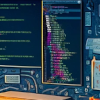 Circa sei mesi fa, per esigenze di gaming di mio figlio, ho deciso di cambiare la scheda video e già che c’ero ho pensato di comprarne una che sia supportata come acceleratore negli apprendimenti di machine learning tra cui keras.
Circa sei mesi fa, per esigenze di gaming di mio figlio, ho deciso di cambiare la scheda video e già che c’ero ho pensato di comprarne una che sia supportata come acceleratore negli apprendimenti di machine learning tra cui keras.
Potevo scegliere una scheda Nvidia con cuda, come la precedente, ma ho optato per una scheda AMD per non avere tra i piedi driver proprietari. Dedicherò una riflessione su questo tipo di scelta, opensource vs proprietario. Le recenti recensione ne parlavano bene e sembrava che il driver rocm funzionasse bene out-of-the-box anche su Ubuntu. Nulla di più sbagliato, nemmeno la versione su docker, quella che doveva essere pronta all’uso, funzionava. Ci ho messo sei mesi per far sistemare tutto correttamente, ovviamente non a tempo pieno, solo nei ritagli di tempo e finalmente tutto funziona.
Step 1: Disinstallare tutti i driver video
sa nvidia con cuda che amd, facendo questo passo ho perso metà del sistema operativo perché tramite il meccanismo delle dipendenze ha disinstallato quasi tutto. Per la mia esperienza è l’unico modo per evitare di rimanere letteralmente incastrati con le dipendenze del driver AMD
Step2: Installazione dei driver AMD
Processo non è banale, o meglio lo è seguendo il processo indicato sul sito, ma rocm non funziona. Almeno per la mia scheda video “AMD Radeon RX 6650 XT”. Dopo l’installazione dell’installer dell’AMD ho modificato a mano i repository da cui scarica i pacchetti, dalla versione 5.7.2 alla versione 6.0.0 “deb https://repo.radeon.com/amdgpu/6.0/ubuntu jammy main”. Le altre versioni non si agganciavano a Keras/tensorflow
Step 3: Installazione di tensorflow
Trovare il giuso match è stata la cosa più complicata. Tensorflow va installato compatibile con la versione rocm presente. Anche qui ho dovuto disinstallare tutte le precedenti versioni e, non so come mai, avevo una libreria pip installata come root, che ovviamente mi ha dato problemi. Anche quella rimossa. La libreria Pythn da installare è tensorflow-rocm 2.13.1.600. Il numero finale 600 indica la versione del driver rocm (600=rocm-6.0.0). L’ultima versione 2.14.0.600 di tensorflow non va con la mia scheda.
Step 4: Configurazione
Siamo alla fine. Il mio è una scheda 6650 con deviceid gfx1032, rocm riconosce solo la scheda 6600 con deviceid gfx1030, quindi è stato necessario forzare il device id. Si può fare o con le variabili d’ambiente o direttamente in pyton con “os.environ[‘HSA_OVERRIDE_GFX_VERSION’] = ‘10.3.0’”, anche qui 10.3.0 indica la versione che corrisponde a gfx1030.
Finalmente la calcolatrice
Per provare ho usato una semplice calcolatrice, ma prima imposto l variabile e verifico che tutto si carichi correttamente
import os
import tensorflow as tf
from tensorflow.python.client import device_lib
os.environ['HSA_OVERRIDE_GFX_VERSION'] = '10.3.0'
print(f'tensorflow version: {tf.version.VERSION}')
tf.config.list_physical_devices('GPU')
device_lib.list_local_devices()Il risultato mostra i dispositivi che tensorflow può utilizzare e quindi:
name: "/device:CPU:0"
name: "/device:GPU:0"Ora il codice della calcolatrice:
import numpy as np
import tensorflow as tf
from tensorflow import keras
import timestart_time = time.time()
with tf.device('gpu:0'):
# Genera dati di training
input_data = np.random.rand(50000, 2)
target_data = np.sum(input_data, axis=1)# Creo un modello semplice
model = keras.Sequential([
keras.layers.Dense(20, activation='relu', input_shape=(2,)),
keras.layers.Dense(20, activation='relu'),
keras.layers.Dense(1)
])
# Compila il modello
model.compile(optimizer='adam', loss='mean_squared_error')
# Addestra il modello
model.fit(input_data, target_data, epochs=5)Infine faccio un po’ di somme
# Testa il modello con nuovi dati
test_data = np.array([[0.3, 0.7], [0.05, 0.10],[5, 10], [1.2, 2.3]])# Testa il modello con nuovi dati
predictions = model.predict(test_data)
# Stampa i risultati
for i, prediction in enumerate(predictions):
print(f"{test_data[i]} = {prediction[0]:.2f}")
1/1 [==============================] - 0s 28ms/step
[0.3 0.7] = 1.00
[0.05 0.1 ] = 0.15
[ 5. 10.] = 14.38
[1.2 2.3] = 3.50Il risultato della calcolatrice non è preciso, come accde sui modelli di reti neurali su cui non è stato fatto tuning, ma serviva per testare la scheda video.
Effetti collaterali
La scheda video è montata sul mio hmetheater-TV come si usava negli anni 2000, monta 2 ricevitori sattelitari, 2 tuner per DVB e controller dei giochi perché viene usato anche come postazione gaming e un device touch per rendere il monitor TV touchscreen. Usare la scheda video per tensorflow fa saltare i buffer video e la tv può essere vsta solo a a una risoluzione HD-rady di 1280×720…. Dedicherò una riflessione sulla scelta dell’opensource

